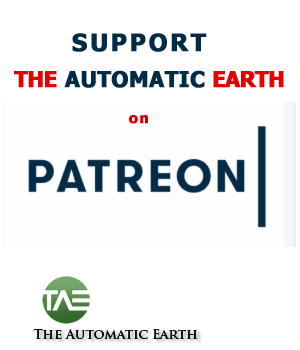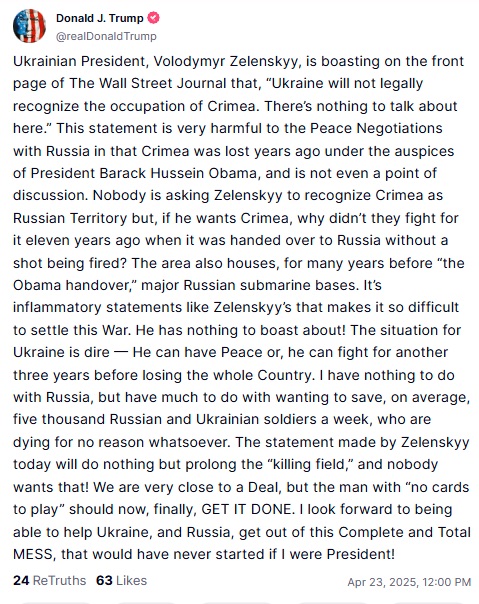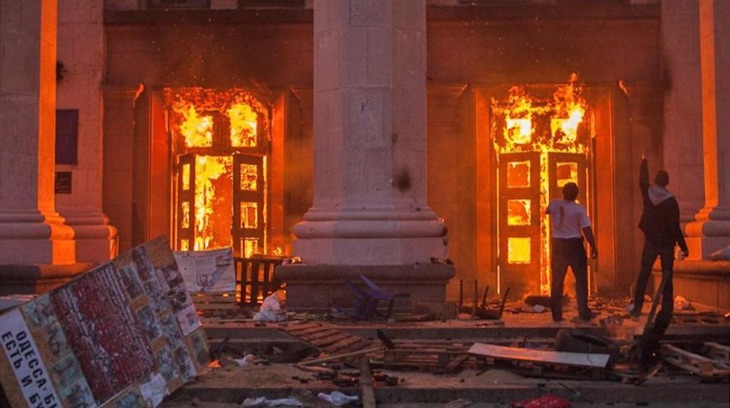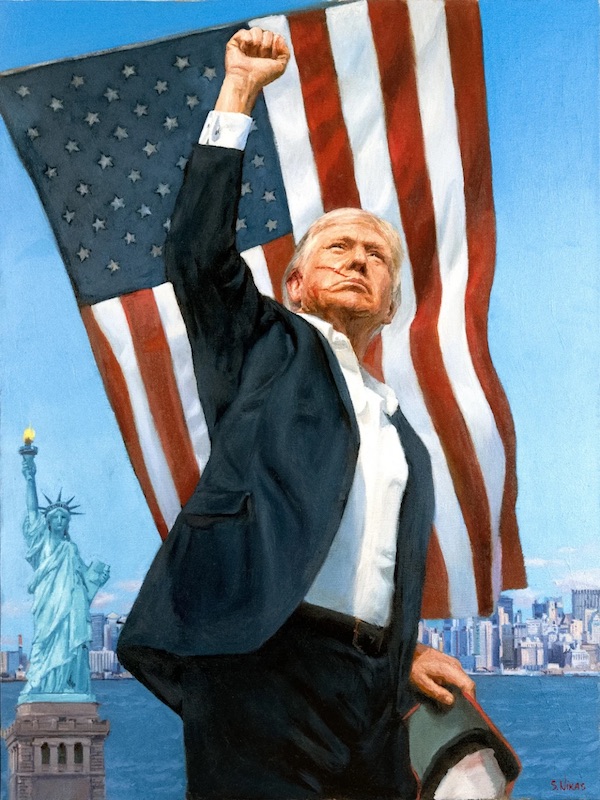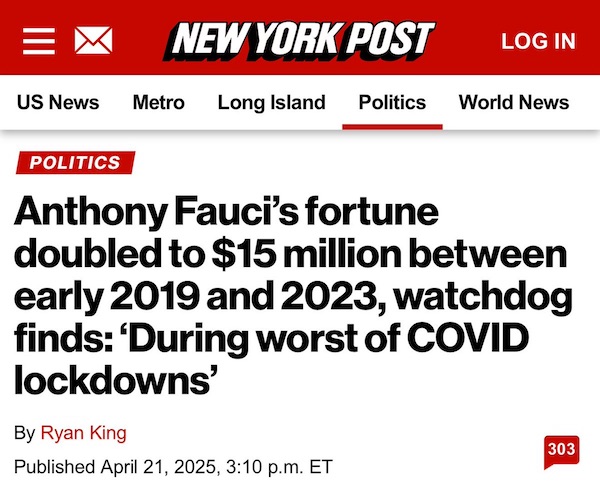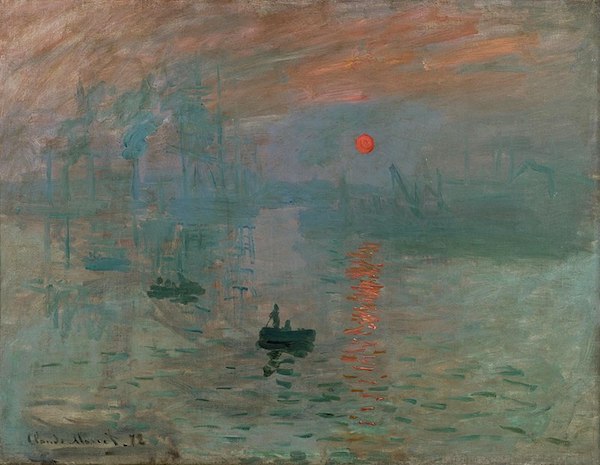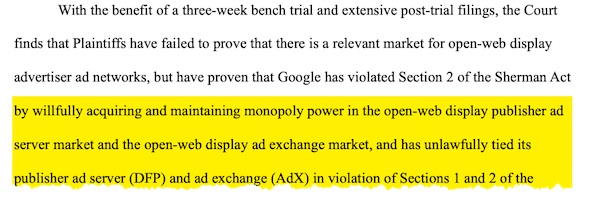
Salvador Dali Archeological Reminiscence of Millet’s Angelus 1933



ELON SAVED A DYING FACTORY & BUILT THOUSANDS OF JOBS IN MICHIGAN@LoFi_Politi_Guy:
“Elon Musk came in, bought up Riviera Tool & Die…because he wanted to start producing his stamping tools in the United States instead of Asia, because he was realizing there's a lot of problems… https://t.co/ZO3APJyD6c pic.twitter.com/gAupH4kHBh
— Mario Nawfal (@MarioNawfal) April 24, 2025
— Elon Musk (@elonmusk) April 24, 2025
Bessent
Scott Bessent explains how the decision by the EU to confiscate Russia's reserves has precluded the Euro from becoming the world reserve currency after Biden confiscated Russia's reserves. If you confiscate foreign reserves your currency tanks. pic.twitter.com/bPhVZGJ3FH
— Robin Monotti (@robinmonotti) April 23, 2025
Tucker Massie
https://twitter.com/BryceMLipscomb/status/1915089434405491163
Hegseth
This is an example of extraordinary leadership.
The Chiefs of all the services need to immediately get behind this directive and start rebuilding faith, confidence and trust back into the force.
Our nation and those service members affected by these unlawful orders must be… https://t.co/bLMdcC1gVW
— General Mike Flynn (@GenFlynn) April 24, 2025
Racist
Worth your while.pic.twitter.com/L29b7bqBaC
— Department of Government Efficiency News (@DOGE__news) April 24, 2025
After returning from SEVERAL meetings at the Trump DOJ, Viceroy Mike Davis @mrddmia wants us all to know:
“Justice is DEFINITELY coming. Let me just assure the War Room Posse, Justice is coming and there’s going to be accountability for this unprecedented Republic-ending… pic.twitter.com/U6gQFTD96B— MAGA Kitty (@SaveUSAKitty) April 23, 2025
The world's fastest swordsman, Guinness World Record holder, Isao Machii.pic.twitter.com/IPWa43ymGG
— Massimo (@Rainmaker1973) April 25, 2025


He’s completely right, but the story has been so distorted over the past three years that few people in the West will recognize that. Ukrainians claim that their army saved the country. But three years ago, in the initial invasion, Russia had Kiev largely surrounded. They retreated because they were tricked by Merkel et al into a “peace deal”.
Point of contention: “..the US will push Russia to acknowledge Ukraine’s right to maintain its military..” Seems doubtful. Russia already beat that military.
• Trump: Russia’s Concession To Ukraine Is Not Taking The Whole Country (ZH)
Reporters in the White House press pool challenged President Trump over some of his latest remarks regarding Ukraine and the possibility of peace. While in the Oval Office sitting across from Norway’s prime minister Jonas Gahr Støre, Trump was asked what concessions Russia has “offered up thus far to get to the point where you’re closer to peace.” He quipped somewhat sarcastically, “Stopping the war, stopping from taking the whole country” — which he called a “pretty big concession.” Zelensky has made clear over the last few days that he’s not on board with Trump’s strategy, which has featured offering recognition of Russian ownership of Crimea as a key concession. These latest words from the US President yet again illustrate that he believes Ukraine has no chance of winning the war, and that he’s being a pragmatist and realist in seeking substantial concessions by Kiev.
When asked about whether the US might (again) cut weapons to Kiev and intelligence-sharing, Trump responded, “Let’s see what happens; I think we’re going to make a deal; ask that question in two weeks.” But Trump apparently plans to keep up the pressure on Moscow. A Thursday Bloomberg report says the US will push Russia to acknowledge Ukraine’s right to maintain its military and defense sector as part of any future peace deal. Steve Witkoff is expected to present the demand to Putin in the next upcoming round of negotiations. Among Putin’s key objectives in the war remains the ‘demilitarization’ of Ukraine.

Crimea is -again- Russian, since 2014. But Zelensky says there isn’t even anything to talk about. Of course Putin gets tired of that. It’s not a serious conversation.
• Trump Slams Zelensky Again (Margolis)
President Donald Trump sharply criticized Ukrainian President Volodymyr Zelensky on Wednesday after Zelensky rejected a U.S.-backed proposal that would have acknowledged Russian control over Crimea as part of a potential peace agreement. Amid ongoing efforts to broker a peace agreement between Ukraine and Russia, Zelensky reaffirmed that Ukraine would not recognize Russia’s control over Crimea. It’s a firm stance, to be sure, but hardly unexpected given the circumstances. “Ukraine will not legally recognize the occupation of Crimea,” Zelensky said in a press conference. “There’s nothing to talk about here. This is against our constitution.”
Trump, however, saw things differently, and in a post on Truth Social called his statement “very harmful to the Peace Negotiations with Russia in that Crimea was lost years ago under the auspices of President Barack Hussein Obama, and is not even a point of discussion.” Trump continued, “Nobody is asking Zelenskyy to recognize Crimea as Russian Territory but, if he wants Crimea, why didn’t they fight for it eleven years ago when it was handed over to Russia without a shot being fired?”
“The area also houses, for many years before “the Obama handover,” major Russian submarine bases. It’s inflammatory statements like Zelenskyy’s that makes it so difficult to settle this War. He has nothing to boast about! The situation for Ukraine is dire — He can have Peace or, he can fight for another three years before losing the whole Country. I have nothing to do with Russia, but have much to do with wanting to save, on average, five thousand Russian and Ukrainian soldiers a week, who are dying for no reason whatsoever. The statement made by Zelenskyy today will do nothing but prolong the “killing field,” and nobody wants that! We are very close to a Deal, but the man with “no cards to play” should now, finally, GET IT DONE. I look forward to being able to help Ukraine, and Russia, get out of this Complete and Total MESS, that would have never started if I were President!”
The President’s remarks underscore the delicate balance required in international diplomacy. While Zelensky may be acting in what he believes is his nation’s best interest, Trump views his stance as a significant impediment to achieving a swift resolution. The Wall Street Journal has more: “Zelensky’s dismissal upends Trump’s latest gambit to halt the war in Ukraine—now in its fourth year—and casts new uncertainty on the future of the relationship between Kyiv and Washington, which Trump has made conditional on a quick deal. American officials had presented a series of ideas for ending the war, including the Crimea proposal, to Ukrainian officials last week and expected an answer on Wednesday at a summit in London, where Ukrainian, U.S. and European officials will gather. Zelensky said Russia should agree to a cease-fire before further talks to demonstrate “serious steps, and not childishness.” He said that Ukrainian officials meeting with U.S. and European officials in London would have a mandate to discuss a partial or full cease-fire, which Ukraine agreed to last month but Moscow rejected.”
A recent poll shows that while more Ukrainians are open to territorial concessions to end the war, rising from 8% in 2022 to 39% now, half the country still firmly opposes giving up any land. Even among those open to compromise, the idea of formally ceding Crimea remains politically untouchable in Ukraine. Officials have denounced the idea as a breach of international law and a dangerous precedent. Crimean Tatar lawmaker Tamila Tasheva warned that such a move would legitimize aggression and encourage future conflicts. Meanwhile, skepticism persists over whether Vladimir Putin is genuinely interested in peace, despite reports of productive talks with intermediaries like special envoy Steve Witkoff.

Plus: No Nukes, No NATO, No Nazis. Nothing changed.
• Peace Will Come When Ukraine Withdraws From 4 Annexed Territories – Peskov (ZH)
Kremlin spokesman Dmitry Peskov has filled in a little bit more of the details in the wake of a Financial Times report issued Tuesday which said President Putin is offering to freeze the current battle lines for the sake of a peace deal. The significant concession came as a surprise to many, who asked what’s the catch. Peskov in Wednesday comments filled in the missing information, stressing that peace can be achieved if Ukrainian forces fully withdraw from territory in the four oblasts Moscow annexed in 2022. Financial Times wrote that “The proposal is the first formal indication Putin has given since the war’s early months three years ago that Russia could step back from its maximalist demands to end the invasion.”
Peskov in the fresh statement emphasized that Russia’s claim to the territories of Donetsk, Luhansk, Kherson, and Zaporizhzhia remain enshrined in its constitution. He was asked directly whether a Ukrainian withdrawal would end the war, to which he responded, “If Ukraine withdraws its troops from these four regions, then yes.” “According to the results of the referendums, these territories have entered the administrative borders of Russia. From our point of view, this is a de jure and de facto situation,” Peskov said. But so far Zelensky hasn’t even been willing to cede Crimea, despite the Russian-speaking population of the strategic peninsula long being firmly in Russian hands, also with its naval Black Sea fleet being stationed there since Soviet Times and throughout recent history.
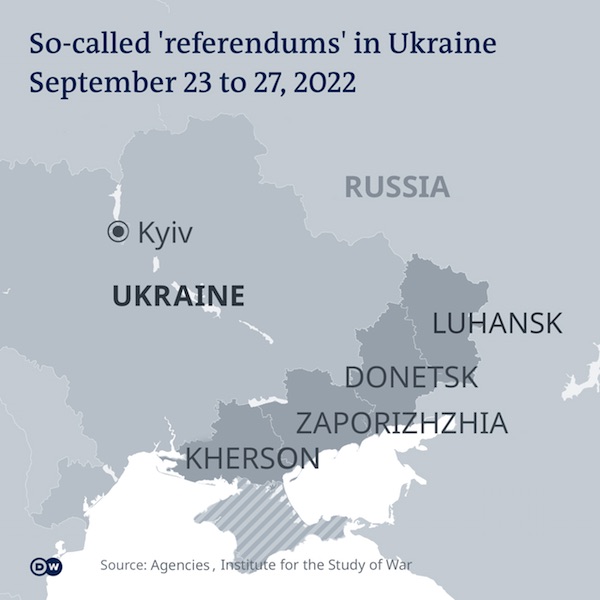
President Trump said Wednesday that Ukraine “lost” Crimea years ago, and so it is “not even a point of discussion”. But Washington’s demands that Ukraine finally compromise on the issue has been rejected by Zelensky. Peskov commented on this too, expressing total agreement with Trump. “This completely corresponds with our understanding, which we have been saying for a long time,” he said. If the Ukrainian government did finally accede to Russia’s demands, it would lose 20% of its total territory, given this is about how much Russian forces currently occupy. The US is also said to currently be offering Ukrainian neutrality vis-a-vis NATO, alongside international recognition of Crimea as Russian territory. But talks have still not gotten off the ground, and the Trump admin is ramping up the pressure on Zelensky especially.

Deaths updated to 12. If there really was such a massive strike, “center of Kiev, large-scale death”, there would be 12,000 deaths, not 12. Russia aims at infrastructure, not people.
• Russia Launches ‘Massive’ Missile Strike On Kiev, Leaving 9 Dead (ZH)
Amid stalled US-led peace talks, Russia launched a massive overnight attack on Ukraine, including raining down ballistic missiles on the center of Kiev, unleashing large-scale death and destruction. At least nine people have been reported killed and over 70 injured in the capital city, in what was one of the largest and deadliest missile strikes on Ukraine in months. Some other cities, including Kharkiv, were also hit. Anti-aircraft systems began engaging inbound missiles and drones at about 1am local time. But after drones and missiles were able to make it through, several buildings – including a factory – and a house, as well as cars, were set on fire. BBC writes, “An apartment block was completely flattened during the attack and the windows of surrounding buildings were blown out and balconies ripped down.” “Russia has launched a massive combined strike on Kyiv,” Ukraine’s state emergency service announced on Telegram. “According to preliminary data, nine people were killed, 63 injured.”
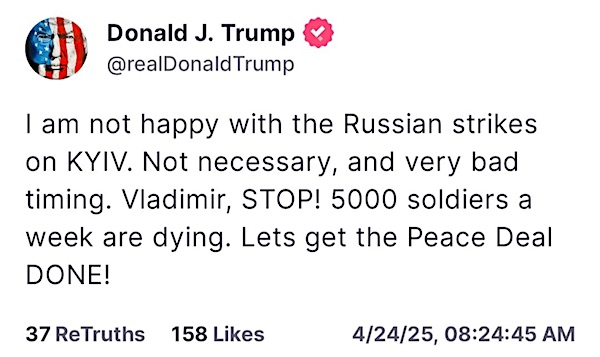
President Trump early Thursday condemned the attack, saying he’s “not happy” with the Russian move. “Vladimir, STOP!” he wrote on Truth Social. “5000 soldiers a week are dying. Let’s get the Peace Deal DONE!” A large rescue effort has been underway given a missile head a densely populated area, with Ukraine’s interior minister, Ihor Klymenko, saying of Svyatoshinsky district of Kiev, “Mobile phones can be heard ringing under the ruins. The search will continue until everybody is got out. We have information about two children who cannot be found at the scene of the incident.” Ukrainian officials have cited that some 70 missiles and up to 150 drones were used against several cities in the devastating overnight attack. This new Thursday attack on the capital was the deadliest since last year’s July 8 attack on Kiev, which left 34 people dead and 121 injured.
It comes after the Zelensky government has expressed frustration that the White House should be more concerned and standing by Ukraine’s side, instead of holding bilateral talks toward diplomatic normalization with Russia. The latest Trump and Zelensky back-and-forth has focused on Crimea. Trump on Wednesday slammed the Ukrainian leader for rejecting a US proposal that would see Kiev give up all claims on Crimea. Trump pointed out that Crimea “was lost years ago” and that Zelensky has “no cards to play”. Zelensky then cited the 2018 “Crimea declaration” by Trump’s then secretary of state Mike Pompeo, which laid out that the United States “rejects Russia’s attempted annexation”. “There is nothing to talk about. This violates our Constitution. This is our territory, the territory of the people of Ukraine,” Zelensky had initially told reporters of the question of giving up Crimea permanently.
But Vice President JD Vance had also articulated while traveling in India, “We’ve issued a very explicit proposal to both the Russians and the Ukrainians, and it’s time for them to either say yes or for the United States to walk away from this process.” He emphasized “The only way to really stop the killing is for the armies to both put down their weapons, to freeze this thing and to get on with the business of actually building a better Russia and a better Ukraine.” Freezing the war now would certainly give Russian forces a huge advantage, given the immense territory in the East they now hold, and this is in large part why Zelensky is refusing such a deal.

“..Kiev is now trying to renegotiate with Washington while simultaneously seeking support from its European sponsors..”
• Ukraine Preparing To Lose US Support – Bild (RT)
The leadership in Kiev is bracing for a “worst-case scenario” in which US President Donald Trump cuts off all American support, the German tabloid Bild has reported, citing anonymous sources within the Ukrainian government. Trump has reportedly increased the pressure on Ukraine to quickly accept Washington’s “final offer” to resolve the conflict. He has also warned that if negotiations between Moscow and Kiev stall, the US may “take a pass” and withdraw from its role as a mediator. “What is on paper and what is being signaled to us in the negotiations is unacceptable,” Bild wrote on Thursday, quoting a Ukrainian diplomat. “We are preparing for the worst-case scenario… and that means an end to US support,” another unnamed government insider told the paper.
The US president has been pushing for a resolution to the conflict, while also seeking a minerals extraction agreement with Ukraine to help offset the billions of dollars Washington has spent on military and financial aid. Trump temporarily halted military supplies and intelligence sharing with Kiev following a public dispute with Ukraine’s Vladimir Zelensky at the White House in February. On Wednesday, Trump reiterated that Zelensky – who he once described as a “dictator without elections” – has been “more difficult to deal with” than Russian President Vladimir Putin. The remark came after Zelensky publicly rejected a reported provision of the US peace framework, insisting earlier this week that Kiev will not even discuss formally recognizing Crimea as Russian territory.
According to Bild, some officials in Kiev hope that Trump’s personal jabs at Zelensky were merely his way to apply pressure. “Our hope was that it was Trump’s negotiating tactic,” the outlet cited a Ukrainian government insider as saying. The report added that Kiev is now trying to renegotiate with Washington while simultaneously seeking support from its European sponsors. Kiev is still receiving weapons pledged by the previous US administration, but no new aid packages have been authorized since Trump took office, Zelensky said on Monday. His recent pleas for additional Patriot batteries and missiles have also gone unanswered.
Moscow has maintained that it is open to peace talks, provided its core security demands are addressed. It opposes any NATO presence on Ukrainian soil and has demanded that Kiev recognize Russia’s new borders and abandon its plans to join the US-led military bloc. Moscow has condemned the continued flow of Western weapons as detrimental to any lasting peace. The Russian government has also said it will not accept a temporary freeze of the conflict, which would only lead to renewed hostilities later on, citing Ukraine’s multiple violations of an Easter ceasefire and an earlier US-mediated moratorium on strikes against energy infrastructure as proof of Kiev’s untrustworthiness.

“Politico said Witkoff was the “main proponent” of the plan, allegedly due to a developing “friendship” with Russian President Vladimir Putin in his role as Trump’s envoy..”
• Rubio and Witkoff Slam Politico Over ‘Fake Crap’ And ‘Fiction’ (RT)
US Secretary of State Marco Rubio and President Donald Trump’s special envoy, Steve Witkoff, have accused Politico of publishing “fiction” and “fake crap,” over a report by the media outlet on a potential Ukraine peace deal. In an article on Wednesday, Politico claimed that Washington is considering lifting sanctions on Russia’s Nord Stream pipeline and “other Russian assets in Europe” as part of its peace efforts. Citing “five people familiar with the discussions,” Politico said Witkoff was the “main proponent” of the plan, allegedly due to a developing “friendship” with Russian President Vladimir Putin in his role as Trump’s envoy. The piece also claimed Rubio opposed the idea and quoted analysts warning it could hurt US LNG exports by reopening the EU market to Russian gas. Rubio was quick to respond, writing on X that the “piece of fiction” was “unequivocally false.” Witkoff responded with sharper language, calling the article “fake crap.”
“There isn't even a kernel of truth to this story – Politico was played by their "sources" yet again. It's embarrassing that they print this type of fake crap.”
-Ambassador Witkoff https://t.co/vZm155LnDa
— Office of the Special Envoy to the Middle East (@SE_MiddleEast) April 24, 2025
Rubio and Witkoff are among the key figures in US-Russia discussions aimed at ending the Ukraine conflict. While the US-proposed peace framework has not been made public, reports suggest it could involve recognizing Crimea as Russian territory. Ukraine’s Vladimir Zelensky recently dismissed any such proposals as “unconstitutional,” prompting Trump to accuse him of jeopardizing the peace process with “inflammatory statements” and warning that he could “lose the whole country” if he does not compromise.
US Vice President J.D. Vance echoed the sentiment, warning on Wednesday that Washington might “walk away” from talks unless Kiev and Moscow reach a deal soon, and stating that “both will have to give up some of the territory they currently own.” Russia has repeatedly said that the status of Crimea and the four other former Ukrainian regions that joined Russia after referendums is not up for negotiation. Moscow insists recognition of the “reality on the ground” is vital for lasting peace. Kremlin spokesman Dmitry Peskov cautioned this week against relying on media reports regarding US-Russia talks, warning that “a lot of fakes are being published now, including by respected publications.” He advised the public to trust official sources instead.

If a tree falls in a forest…
• European Leaders Rejected US Proposal On Crimea – FT (RT)
European leaders have rejected a US proposal to recognize Russia’s sovereignty over Crimea as part of a draft peace deal on the Ukraine conflict, the Financial Times reported on Thursday. European officials told the outlet that such a move could cause a rift within NATO and force Kiev’s backers to choose between sticking with Ukraine or siding with Washington. According to the report, US President Donald Trump’s team has presented Ukraine with a take-it-or-leave-it deal that includes Washington formally recognizing Crimea as Russian territory. US Vice President J.D. Vance has also suggested freezing the conflict along the current lines of control. A senior European diplomat told the FT that it would be “impossible” to accept the US proposal, while one EU official claimed that “Crimea and future NATO membership aspirations are red lines for us.”
Ukraine’s Vladimir Zelensky has also refused to even consider conceding Crimea, stating that the country’s constitution prohibits such a move. Trump has criticized Zelensky’s stance, calling it “very harmful” to peace negotiations and stating that “Crimea was lost years ago.” “He can have Peace or, he can fight for another three years before losing the whole Country,” the US president wrote on social media this week. Officials cited by the FT said that if Trump unilaterally recognizes Crimea or lifts sanctions on Russia, it could trigger a severe split within NATO as well as the EU.
The Trump administration recently warned that the US could end its involvement in Ukraine peace talks if there is no progress soon, but also noted he has found it easier to negotiate with Russia than with Zelensky. Moscow has expressed appreciation for the Trump administration’s efforts to negotiate a settlement of the conflict, and has indicated that it will maintain contact with Washington on the issue. At the same time, Russian officials have said that Kiev and its European backers don’t appear to want the conflict to end and are consistently undermining peace efforts.

“The EU’s turn toward Russophobia is not strategic—it is compensatory. Western Europe’s global credibility continues to erode. The reason is simple: a lack of empathy and introspection. The continent views the world through a mirror, seeing only itself.”
• Russia Watches Western Europe Closely. It Has Reasons To Worry (Bordachev)
Western Europe is once again returning to a familiar role: a primary source of global instability. For Russia, this presents a critical question—should we simply turn our backs on the West and focus entirely on our eastern partners? Judging by the current trend in Russian foreign trade of Asian countries steadily taking a larger share, this conclusion may appear reasonable. Yet such a strategy, while tempting, is short-sighted. From antiquity to the present, Europe has often served as a destabilizing force. From the Greek island raiders who disrupted the Nile Valley civilizations, to modern Western European meddling in Africa and aggression in Ukraine, the continent has rarely chosen diplomacy over division. The dismantling of colonial empires and Western Europe’s post-war subordination to the United States softened this tendency. But today, old habits are re-emerging.
European political rhetoric may sound hollow, even absurd, given the continent’s dwindling economic and demographic weight. However, that does not make it less dangerous. Europe is no longer the heart of global politics, yet paradoxically remains its most likely flashpoint. Here, the possibility of a direct military clash between great powers remains disturbingly real. For Russia, Western Europe is a historical adversary, one that has long sought to dictate terms or impose its will. From Napoleon to Hitler, and now to Brussels’ bureaucrats, attempts to subdue or marginalize Russia have been met with fierce resistance. This enduring conflict defines much of our shared history. Today, facing its own developmental dead ends, Western Europe once again turns outward in search of a scapegoat. This time, the preferred solution is militarization, supposedly to counter a “Russian threat.”
The irony is obvious. The EU’s grand vision of integration is in disarray. Its socio-economic models are faltering. Britain, now outside the bloc, is no better off. Aging populations, failing welfare systems, and uncontrolled migration are stoking nationalist sentiments and pushing elites toward more radical postures. Finland, once neutral and pragmatic, now also leans into anti-Russian rhetoric to mask its growing internal malaise. Meanwhile, the institutions that once underpinned European unity are crumbling. The EU’s central structures in Brussels are widely viewed with disdain. National governments resist ceding further power, and the criteria for leadership within the bloc seem to have become cynicism and incompetence. For over a decade, the top posts have gone not to visionary leaders, but to pliable figures chosen for their loyalty and lack of ambition.
Gone are the days of Jacques Delors or even Romano Prodi, who at least understood the value of dialogue with Russia. In their place, we have figures like Ursula von der Leyen and Kaja Kallas, whose inability to achieve anything meaningful within the bloc leads them to seek relevance by provoking confrontation with Moscow. The EU’s turn toward Russophobia is not strategic—it is compensatory. Western Europe’s global credibility continues to erode. The reason is simple: a lack of empathy and introspection. The continent views the world through a mirror, seeing only itself. This solipsism, coupled with economic stagnation, makes it harder for its leaders to convert its shrinking economic advantages into geopolitical influence. Africa offers a telling case. France’s influence, once substantial in its former colonies, is rapidly vanishing. Local governments, tired of paternalistic lectures and ineffective policies, are turning instead to Russia, the United States, or even China to build new partnerships.
Even Western Europe’s relationship with the United States is entering a phase of uncertainty. As internal divisions grow in America, European elites accustomed to strategic dependence now find themselves increasingly anxious. They are unsure whether Washington will continue to shield them, or whether they will be left to face the consequences of their own miscalculations. This insecurity partly explains the EU’s heightened hostility toward Russia: it is a desperate bid for attention and relevance. Representatives of the new US administration have already hinted at the lack of real strategic contradictions with Russia. Such statements provoke panic in Brussels. Western European elites fear a US-Russia thaw that could leave them sidelined. They know Washington will not grant them independence in foreign policy, but they also fear that its patronage will no longer come with privileges.

“Not even at Easter was it possible to have a little respite, because, ultimately, no one in the West really wants peace.”
• Strategy Does Not Rhyme With Hypocrisy (Pacini)
The President of the Russian Federation, Vladimir Vladimirovich Putin, had called for an “Easter truce” on the occasion of the liturgical solemnity, celebrated this year throughout the Christian world. This was a sign of strong attention to the human dimension of war, too often forgotten in favor of journalistic narratives and the utility of politicians who profit from the blood of young people dying at the front, but also further proof of Russia’s willingness to find sensible and rational solutions to the conflict. Solutions that, once again, have been manipulated and exploited by the enemy. There is no peace even at Easter. In fact, Ukraine took advantage of the truce to turn the media narrative in its favor. The attack was twofold:
– In the media, Ukraine first accused Moscow of spreading falsehoods and, once the truce actually began (only on the Russian side), repeatedly accused Russia of continuing its attacks, repeatedly violating the truce. – The affair served to cover up and make people forget as much as possible about the events in Sumy, or Bucha 2025. – Strategically, Ukrainian soldiers tried to resupply some frontline positions and break through at some sensitive points, failing to do so but effectively firing on the enemy even though they knew it was a pause in the conflict. In Jus in bello, the law of war, a truce is a temporary suspension of hostilities agreed upon by the parties. When declared unilaterally by one party, it is not usually considered legally binding, but may nevertheless have practical and legal implications.
The Hague Convention of 1907, in Article 36, defines a truce as “the suspension of hostilities between the belligerents for a period fixed by them, either directly or through mediators.” Therefore, when only one party calls for a truce, there is no international legal obligation, but there is nevertheless a strong moral and political value, which generally demonstrates a clear willingness to respect and protect the needs and safety of civilians, as well as to attempt negotiation. There is always an open military risk. It is precisely the political nature of the affair that is strategically interesting. Kiev deliberately sabotaged the Easter truce because it is interested in continuing the military conflict. The Russian Ministry of Defense reported more than 50 attacks within the border areas with civilian casualties, including a 2-year-old girl in the Belgorod region. In addition to the bombing of Russian army positions, civilian areas in Kherson, Zaporizhzhya, Donetsk, and Lugansk were also attacked. On the global political scene, the unelected permanent president Zelensky has shown great hypocrisy, trying to manipulate Putin’s goodwill, but without success. The result is a demonstration of war mongering and a lack of humanity.
After the expiry of the “Easter truce,” Russian troops attacked the industrial zone of the “Storm” research institute in Odessa. The Russian Ministry of Defense also reported the detonation of an ammunition depot in the Kirzhach area due to a violation of safety regulations. Towards Sumy, Russian troops continued their offensive and liberated the Gornalsky monastery, also advancing into the fields towards Oleshnya. Towards Dzerzhinsky, Russian troops moved to fight on the outskirts of Dachnoye, partially surrounding Ukrainian Armed Forces units in the village. Fighters from the Russian Armed Forces’ 68th Tank Regiment are advancing north of Valentinovka and driving the enemy out of most of Sukha Balka. In terms of international politics, however, it is interesting to draw attention to what was announced by Donald Trump, who had planned to stop the war by Easter, or to obtain a truce of at least 30 days. None of this worked. The U.S. has once again confirmed that it is far from having any real capacity to intervene and influence the Russian-Ukrainian conflict.
[..] On the EU/NATO side, Kaja Kallas chastised the U.S. for not using effective tools to put pressure on Russia, stating that “They have tools in their hands to actually put pressure on Russia. They have not used those tools,” and acknowledging that Russia is winning the game. She said that the EU, for its part, will never recognize the peninsula as Russian: ”Crimea is Ukraine. It means a lot to those who are occupied that others do not recognize this as Russian.” The EU therefore wants endless war with Russia under Washington’s umbrella, because it knows that Europe alone would not be able to survive a single day. Not even at Easter was it possible to have a little respite, because, ultimately, no one in the West really wants peace.

“In the end, any blockade attempt will only amount to another strategic failure by the West — which continues to underestimate an adversary historically accustomed to resisting — and winning — when encircled.”
• Russia Can Break Any Naval Blockade (Leiroz)
The West’s hostile rhetoric against Russia has taken on increasingly aggressive tones, revealing a coordinated effort to isolate Moscow across all spheres — including the maritime domain. Russian presidential aide Nikolay Patrushev recently stated that the European Union and the United Kingdom are currently preparing a naval blockade against Russia, a measure that constitutes a clear violation of international law and signals an unprecedented escalation in geopolitical tensions. More than a symbolic or diplomatic gesture, such a naval siege amounts to a declaration of economic and strategic warfare. Patrushev warned that Russia has more than enough means to respond to any provocation of this kind. He made it clear that, in the event of diplomatic failure, the Russian Navy would be authorized to take whatever measures are necessary to protect the country’s shipping.
First, it is necessary to understand what kind of “blockade” the West is planning to impose. In recent times, Western countries have threatened Russian vessels in various areas of the Atlantic Ocean, particularly in the Baltic Sea, which NATO increasingly treats as its own “lake” — while ignoring the military stronghold of Kaliningrad. Russian ships have also faced patrols and threats near ports and territorial waters of European nations, a situation that is becoming increasingly troubling. However, while there is still insufficient information to determine the West’s real intentions, it is essential to consider the possibility of a full-scale physical encirclement strategy. Although clearly impossible in a direct and frontal manner, such an idea could be pursued progressively through small-scale naval provocations along multiple routes close to Russian shores.
In this context, two key pillars would define Russia’s defensive strategy: the Arctic — where Moscow has built one of the world’s largest military infrastructures — and Russia’s colossal nuclear capability. Over the past decades, Russia has turned the Arctic into a strategic bastion. It now hosts not only highly equipped naval and air bases, but also alternative trade routes and power projection corridors — such as the Northern Sea Route, which is becoming increasingly viable with the melting of polar ice caps. Russia’s Northern Fleet, equipped with next-generation nuclear submarines and cruisers armed with long-range missiles, is strategically positioned to ensure the country’s maritime sovereignty and to prevent any logistical strangulation attempts. More than a defensive zone, the Arctic now functions as an offensive platform allowing Russia to project power not only across the North Atlantic and the Barents Sea, but also along European coastlines, if necessary.
The Western attempt to encircle Russia fails to consider this critical factor: Moscow is not bound by traditional routes, nor does it rely on the goodwill of European ports — its ability to break blockades is real and already operational. In parallel, Moscow is advancing an ambitious naval modernization program, incorporating autonomous systems, new operational doctrines, and a strategic posture that avoids the trap of an arms race but ensures regional superiority. Russia is not seeking direct confrontation, but it is prepared for it — across multiple domains, including the strategic one. And this is where nuclear deterrence comes into play — an element the West insists on ignoring or downplaying in its propaganda, but which remains the primary guarantor of Russian security. The nuclear doctrine of the Russian Federation is clear: in the face of an existential threat — even if not in the form of a direct nuclear attack —, the response may escalate to the use of nuclear weapons. This is not an empty threat, but a pillar of global stability — the same one that prevented direct conflict throughout the Cold War.
Russia’s strategic patrol submarines, many of them operating from Arctic bases, maintain a constant second-strike capability. Their warheads, dispersed and well-protected, ensure that any Western aggression can be met with devastating force. Thus, a naval blockade becomes not just a provocation, but a global risk — one that could trigger a conflict of unpredictable scale. Given this, it is up to the West to reflect on the consequences of its actions. London and Brussels may believe they can suffocate Russia with unilateral measures, but they deliberately ignore the military and geostrategic realities of the 21st century. The Russian Federation is not a vulnerable state; it is a fully capable power, ready to defend its vital interests — whatever the cost. The illusion of a successful naval siege says more about Western arrogance than about any Russian weakness. In the end, any blockade attempt will only amount to another strategic failure by the West — which continues to underestimate an adversary historically accustomed to resisting — and winning — when encircled.

“Prior to Rubio’s arrival in Foggy Bottom, the State Department had 734 different offices, many with redundant tasks and responsibilities. Now, Rubio aims to decrease that number to 604 with the closure of 132 offices..”
• Rubio and Trump’s Unfinished Business with ‘Bloated’ State Department (Devlin)
If it hasn’t been made clear enough by now, President Donald Trump and his administration have unfinished business from his first term.That feeling is especially acute at the State Department. The first Trump administration’s plans to revive the American system were undermined by leakers and turncoats who sought to preserve the status quo. Such was the case at the State Department: When Trump proposed transformative cuts in 2017, the president faced resistance not just from deep state actors but from his own political appointees and Republicans in Congress. The four-year interregnum of President Joe Biden culminated in Trump’s return to Washington more powerful and more popular than ever. The mandate victory exposed just how wrong the establishment was in thinking the American people wanted Trump-lite—the American people wanted full-bodied Trump.
Secretary of State Marco Rubio has brought that message to Foggy Bottom. On Monday, Rubio announced the most aggressive reorganization of the State Department in modern American history. This “comprehensive reorganization plan,” Rubio said in a statement, “will bring the department into the 21st Century.” Prior to Rubio’s arrival in Foggy Bottom, the State Department had 734 different offices, many with redundant tasks and responsibilities. Now, Rubio aims to decrease that number to 604 with the closure of 132 offices, according to a report from The Free Press. The nearly 20% reduction in State Department offices will come with the elimination of 700 civil service and foreign service employees. Beyond the closure of 132 offices, 137 offices will be consolidated into other divisions of the agency. Furthermore, the elimination of 700 foreign and civil service roles is just the tip of the iceberg, as Rubio has instructed his undersecretaries to produce plans within 30 days to slash their staff by 15%.
Some of the offices Rubio is looking to downsize employ thousands of people, thanks to the rapid growth of state department staffing over the last few decades. Prior to World War II, the State Department employed about 1,000. By 1946, the State Department had grown to 17,000 employees, somewhat understandable to meet the needs of the war and its aftermath. Today, the State Department employs around 80,000 people between foreign service, civil service, and locally employed staff. Cold War hires? No. In the year 2000, State Department employees numbered just over 30,000. In 25 years, the agency has nearly tripled in size. All the while, the Department of Defense has played an increasingly important role in international diplomacy at the expense of the State Department. Core State Department functions and efficacy have been undermined, due in no small part to over bureaucratization and left-wing capture that has diverted oodles of taxpayer dollars to liberal pet projects.
Rubio himself described the department as “bloated, bureaucratic, and unable to perform its essential diplomatic mission in this new era of great power competition”: In the early days of Trump 1.0, the administration proposed a 28% cut to the State Department budget, with a $25.6 billion budget between the State Department and USAID. The proposal, Tillerson told State Department employees in an email at the time, “acknowledges that U.S. engagement must be more efficient, that our aid be more effective, and that advocating the national interests of our country always be our primary mission.” Those deep cuts failed to materialize, and Democrats were not solely to blame. Republicans in Congress opposed the plan, as well. Then-Majority Leader Mitch McConnell, R-Ky., said he was “not in favor” of the cuts.
The late Sen. John McCain, R-Ariz., also said he was “very much opposed.” Sen. Lindsey Graham, R-S.C., went further, claiming Trump’s State Department cuts were “dead on arrival” and that “it would be a disaster.” Even Rubio expressed concerns at the time. Graham’s prediction turned out to be true: Republicans in Congress failed to deliver on the cuts that would have assisted Trump’s reform efforts. By 2021, the State Department saw a 2,000-person drop in foreign service staffers and still fewer reductions in civil service staff, but this was mostly credited to attrition and retirements. Now, Rubio is prepared to go farther than anyone in the first Trump administration—much less Rubio himself—imagined in 2017.

“According to The Times, the UK-French plan was rolled back during talks in the UK capital on Wednesday.”
• ‘Coalition of The Willing’ Resolve Eroding – The Times (RT)
France and the UK displayed a weakening resolve to put boots on the ground in Ukraine, during recent talks in London, The Times has reported, citing anonymous sources.Defense chiefs from a number of European NATO states have been debating deploying forces to Ukraine as part of a self-titled “coalition of the willing.” The idea, led by France and the UK, was proposed as a means of providing Kiev with security guarantees in the event of a ceasefire with Russia. Moscow has rejected outright the idea of troops from the US-led military bloc being deployed to Ukraine under any pretext. According to The Times, the UK-French plan was rolled back during talks in the UK capital on Wednesday.
“Sir Keir Starmer and President Macron of France have offered to deploy troops to Ukraine to keep the peace as part of a ‘coalition of the willing,’ but during talks in London sources told The Times there appeared to be a softening of the commitment,” the newspaper wrote on Wednesday. However, a defense source told the outlet that the UK is not prepared to abandon the plans entirely. Some European officials realise that Moscow would never tolerate the deployment of a force of NATO members’ troops to Ukraine, The Times reported. Russia has warned that it will consider such a troop presence as a NATO deployment, under the guise of peacekeepers or otherwise, and will treat it as a valid military target. Moscow has repeatedly stated that NATO’s eastward expansion and Kiev’s aspirations to join the military bloc are among the root causes of the Ukraine conflict.
The deployment of NATO troops in Ukraine could lead to a direct clash between the US-led bloc and Russia, setting off World War III, Russia’s National Security Council Secretary and former Defense Minister Sergey Shoigu has said. The troop deployment plan comes as EU states have floated a $840 [billion] militarization plan for the bloc, citing a perceived threat from Russia. Moscow has repeatedly criticized the EU’s continued flow of armaments to Ukraine, arguing that Western European nations appear more interested in prolonging the fighting rather than resolving the conflict diplomatically.

“..the conference that declared “A New World Order with European Values.” Various Americans were present to reaffirm the worst about the United States..”
• Leading Liberals Call Upon Europeans to Resist the United States (Turley)
In his historic speech in Munich this year, Vice President J.D. Vance confronted the Europeans over their attacks on free speech, declaring “If you are running in fear of your own voters, there is nothing America can do for you.” That is manifestly true, but it appears that there is something that certain Americans can still do for Europe. As the European Union ramps up its long-standing campaign against free speech, it is increasingly calling upon Americans to make the case against both free speech and the United States. The Europeans and globalists see the Trump Administration as a threat in the effort to create transnational governance systems. German diplomat Christoph Heusgen became emotional in responding to Vance, declaring “It is clear that our rules-based international order is under pressure. It is my strong belief that this more multipolar world needs to be based on a single set of norms and principles.”
American politicians and journalists quickly added their voices of condemnation. CBS anchor Margaret Brennan confronted Secretary of State Marco Rubio to suggest that Vance’s support for free speech was outrageous because he was “standing in a country where free speech was weaponized to conduct a genocide.” Brennan’s bizarre suggestion that free speech contributed to the death camps was amplified by Rep. Seth Moulton (D-MA) who accused Vance of using “some of the same language that Hitler used to justify the Holocaust.” After the Munich speech, some of the leading anti-free speech figures in the world gathered at the World Forum in Berlin. I was one of the few speakers from the free speech community at the conference that declared “A New World Order with European Values.” Various Americans were present to reaffirm the worst about the United States as a nation descending into tyranny.
The two most celebrated figures were Bill and Hillary Clinton, who also criticized the current Administration. The appearance of Hillary Clinton was particularly chilling for the free speech community at the Forum. Clinton has been unrelenting in her attacks on free speech and is a favorite of globalists who want to create this new world order. After Musk bought Twitter with the intention of restoring free speech protections, Clinton called upon the European Union to use its infamous Digital Services Act to make Musk censor her fellow Americans. She has also suggested arresting those spreading disinformation. The EU did precisely that and is now threatening Musk with confiscatory fines unless he resumes the censorship of Americans and others. After returning from Berlin, I testified in the Senate Judiciary Committee and warned about the building threat to free speech from the use of the DSA.

China sends out all sorts of people commenting. But Trump wants to talk to XI one-on-one. No “point person for the dialogue..” or anything like that.
Xi bets on Americans turning on Trump, if things get more expensive. But China, too, has domestic breaking points.
• China Dismisses Reports Of US Trade Progress As “Fake News” (ZH)
Wednesday’s equity market rollercoaster—sharp pops and drops—was driven by conflicting reports on headlines surrounding potential U.S.-China trade talks. Markets surged after a Wall Street Journal report suggested President Trump considered cutting steep tariffs on Chinese imports. But sentiment quickly reversed when Reuters poured cold water on the claim. Further declines followed after Treasury Secretary Scott Bessent clarified there had been “no unilateral offer from Trump” to reduce Chinese tariffs and that a trade deal could take two to three years to finalize. In the overnight hours, China demanded Washington remove unilateral tariffs before engaging in trade talks and rejected the claim that any negotiations had progressed.
“The US should respond to rational voices in the international community and within its own borders and thoroughly remove all unilateral tariffs imposed on China, if it really wants to solve the problem,” Ministry of Commerce’s spokesman He Yadong told reporters at a regular briefing on Thursday in Beijing. Yadong rejected any signs of progress in bilateral communications, indicating that “reports on development in talks are groundless.” He said Washington needs to “show sincerity” if both sides want to make a deal. Ministry of Foreign Affairs spokesperson Guo Jiakun also called any rhetoric coming from the Trump administration about deal progress “fake news” in a press conference.
The Trump administration’s softening stance—reported by the WSJ, which sent US equity markets higher early Wednesday—may signal a willingness by the US to de-escalate the trade war with Beijing in order to shift to the negotiating phase. Trump told reporters on Wednesday: “Maybe we’ll make a special deal, and we’ll see what it will be. Right now, [the tariffs are] 145%, that’s very high.” One day earlier, Treasury Secretary Bessent told investors at a closed-door meeting: “No one thinks the current status quo is sustainable, at 145% and 125%, so I would posit that over the very near future, there will be a de-escalation. We have an embargo now on both sides.” Alfredo Montufar-Helu, senior adviser at The Conference Board’s China Center, told the Shanghai Morning Post that “news today confirms China has no intention to reach out first with a proposal of its own.”
“The impasse in negotiations is driven by a very simple dynamic; no side wants to bear with the political costs of being seen as capitulating to the other side,” Montufar-Helu explained. According to Zhang Zhiwei, chief economist at Pinpoint Asset Management, even if the negotiations between China and the US start immediately, reaching an agreement could take time, and mounting risks exist. The tariff war on both sides could soon unleash pain across global trade. “It takes time for trade negotiations to proceed between the US and other countries. This means the tariffs will hit global trade and economies for at least several months. It is not clear to what extent inventory build-up and pre-loading of trade in the past few months will help to soften the immediate damage. The question now is how bad trade and other macro data will be in China, the US and other countries,” Zhiwei said.
[..] Bloomberg reported last week that Beijing wants to see several things from Trump’s administration before trade talks begin, such as more respect and naming a point person for the dialogue. Neither side has announced any upcoming bilateral trade meetings despite Trump’s announcement this week to ease tariffs potentially.

“..the EU people want to help the American Left, and one of the ways they think they can is to stonewall and watch the bond and stock market go down.”
• The Method Behind the Madness of Trump’s “Tariff Wars” (Victor Davis Hanson)
Where are we in the trade wars, the tariff wars? The stock market recently has recovered somewhat. We’re about where it was in August. I didn’t think it was too bad in August of 2024. It’s recovering 1% to 2%, on occasion. And why is that? Because Donald Trump has announced that JD Vance and his wife, who is of Indian legacy—her family was born in India—met with the Indian government officials, and there may be a trade deal. Japan has been talking with us. They both want—us and Japan—want a deal. Japan says we moved the goalpost. We say, “They’re not serious.” But there’s going to be a deal there. And more importantly, Donald Trump said he was willing to lower tariffs on China. Now the Left says, “Oh, he’s caving, he’s caving. This was all unnecessary.” You could interpret it that way. But it’s more likely “Art of the Deal.”
In other words, “We’re going to invade Panama,” but we’re not going to invade Panama. We just want Panama to let American companies run the exit and the entry to the canal—and that’s probably going to happen. “Canada’s going to be the 51st state.” No. It’s not going to be the 51st state. But Canada should defend themselves and pay 2% of their GDP, and they need to address a $65-$100 billion deficit. But, “We want to absorb Greenland.” No. We don’t. We want Denmark—a colonial power with this huge North American colony—we want them to help them a little bit. And indeed, they’re starting to put Greenland on their imperial flags, and they gave them a billion dollars, and the base is secure. And the Greenland people, 50,000 or so, will want U.S. security. So, that is the “Art of the Deal.”
And to get China to come and reduce its $300 billion trade surplus with the United States, Donald Trump talked about these huge tariffs. Now, he will talk down and we’ll probably get a deal in an “Art of the Deal” fashion. We saw that with NATO. He harangued them in 2018. They were furious. Said he might not come to their aid. They haven’t met their 2%, 2014 promises. And guess what? They started to spend more in defense. Timely so, because when the Ukraine war broke out, Europe had spent a billion dollars more on defense expenditure. And more importantly, they had Finland and Sweden, two of the most muscular of all the European nations in terms of munitions and defense readiness, now both part of NATO. That worked.
And I think the same thing is happening with trade. Here’s the dynamic: the Europeans detest Donald Trump more than they see their self-interest. In other words, they would rather be on the outside of these trade negotiations and punish Donald Trump than they would be with the Asian powers and make a deal and profit, mutually with the United States. And partly that’s because they’re akin to the American Left. And, as we saw with Jamie Raskin, a representative in the Congress, he said to each country, “If you cut a deal with this administration [the Trump administration] we’re going to remember that.” So, the EU people want to help the American Left, and one of the ways they think they can is to stonewall and watch the bond and stock market go down. And then they could come in later with more favorable concessions from the United States.
The problem with that thinking is that if India cuts a deal and South Korea cuts a deal—and now they’re talking about Japan, Taiwan, Australia—the Trump administration has already established, openly, transparently, that those countries that are first to cut a deal will get the most favorable terms. And so, the more people that come in and have a reciprocal agreement with the United States—I’m not saying it’s going to be parity. I’m not saying we’re going to get down to zero deficits—but if we cut this trillion-dollar deficit by half, that will be a considerable achievement. The Europeans, then, will see that they’re left out. And especially if we come to an accord in the next month or so with China—not that we’re going to be able to force China to have no tariffs on their part. But we might be able to lower them and then make them buy American products to reduce that $300 billion—If that were to be true, then Europe has missed the boat.

Lawfare doesn’t rhyme with election integrity. The President can’t order fair elections, only Congress can.
“The Democratic National Committee and left-leaning nonprofit groups sued to block the order from being implemented, claiming it would cause voter suppression..”
• About the Judge Blocking Trump’s Election Integrity Order (Fred Lucas)
U.S. District Judge Colleen Kollar-Kotelly blocked part of President Donald Trump’s executive order on election integrity. Kollar-Kotelly, who was appointed to the District Court for the District of Columbia by President Bill Clinton in 1997, has a history of left-leaning decisions on free speech, transgender policy, terrorist detention, and more recently, the Department of Government Efficiency, or DOGE. The Democratic National Committee and left-leaning nonprofit groups sued to block the implementation of the order. Kollar-Kotelly granted the plaintiffs’ request for a temporary injunction and noted they are likely to prevail. “Our Constitution entrusts Congress and the states —not the president–with the authority to regulate federal elections,” Kollar-Kotelly wrote in the opinion.
JUDICIAL COUP https://t.co/eKR2kHM8zs
— Stephen Miller (@StephenM) April 24, 2025
“Consistent with that allocation of power, Congress is currently debating legislation that would effect many of the changes the president purports to order. And no statutory delegation of authority to the executive ranch permits the president to short-circuit Congress’s deliberative process by executive order.” The judge blocked provisions in the executive order to add documentary proof of citizenship to the standardized national voter registration form. She also blocked the portion of the order that requires federal agencies to assess citizenship before providing a federal voter registration form to people receiving public assistance. Trump’s order adds citizenship scrutiny to the national mail voter registration form, withholds federal grants from states that count mail ballots arriving after Election Day, gives states more access to a federal database to better verify voter registration lists, and directs the Justice Department to prioritize enforcing voting laws.
Trump’s order addressing voter registration lists is significant. As noted in my book, “The Myth of Voter Suppression,” states and localities across the United States have failed to update their voter registration lists to eliminate dead people, people who have moved, or people who are not citizens. Failing to update the voter rolls is a violation of the 1993 National Voter Registration Act. The Democratic National Committee and left-leaning nonprofit groups sued to block the order from being implemented, claiming it would cause voter suppression. Here are six things to know about Kollar-Kotelly.

Mass hysteria manifested in the flesh.
• UK To Greenlight Experiments To “Dim The Sun” In Bid To Stop Global Warming (ZH)
It’s a project reminiscent of the movie Snowpiercer, in which governments institute a global experiment to spray chemicals into the atmosphere to stop global warming and end up creating a new ice age instead. Once again reality is downstream from fiction as the UK is set to bankroll an experiment to “dim the sun”. This goal will be pursued in field trials which could include injecting aerosols into the atmosphere, or brightening clouds to reflect sunshine. The project is being considered by scientists as a way to prevent “runaway climate change”, despite the fact that there is zero evidence to support the claim of runaway climate change. Aria, the Government’s advanced research and invention funding agency, has set aside £50 million for projects, which will be announced in the coming weeks.
Prof Mark Symes, the program director for Aria (Advanced Research and Invention Agency), said there would be “small controlled outdoor experiments on particular approaches”. “We will be announcing who we have given funding to in a few weeks and when we do so we will be making clear when any outdoor experiments might be taking place,” he said. “One of the missing pieces in this debate was physical data from the real world. Models can only tell us so much. Everything we do is going to be safe by design. We’re absolutely committed to responsible research, including responsible outdoor research. We have strong requirements around the length of time experiments can run for and their reversibility and we won’t be funding the release of any toxic substances to the environment.” One major area of research is Sunlight Reflection Methods (SRM), which includes Stratospheric Aerosol Injection (SAI) whereby tiny particles are released into the stratosphere to reflect sunlight.
Another potential project is Marine Cloud Brightening (MCB) in which ships would spray sea-salt particles into the sky to enhance the reflectivity of low-lying clouds. Climate scientists say efforts to reduce carbon emissions are not working fast enough and that levels are “too high”, leading to irregular weather patterns and eventually the temperature “tipping point” in which an exponential crisis is created by heat creating carbon and then carbon creating more heat. The problem is that nothing in this theory is backed by causational evidence or the climate history of the Earth. In other words, climate scientists are siphoning up government grant money to create solutions to a problem that doesn’t exist. The vast majority of climate change theories are based on data collected since the 1880s – 140 years of data is a insignificant window of time in the long lifespan of the Earth’s climate.
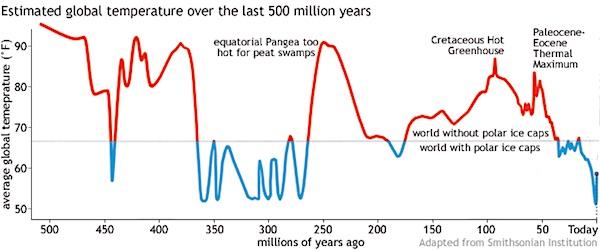
When we look at the temperature data over millions of years, we find that today’s temps are near the lowest in our planet’s history (we just exited an Ice Age not long ago and climate scientists want us to believe it’s too hot).

When comparing millions of years of carbon data to parallel temperature data, it becomes clear that there is no correlation between carbon levels and global warming. This graph also proves that carbon and temperature levels can rise and fall independently of human industry and human industry’s effects on these patterns is negligible or non-existent.

There is also no data to prove correlation or causation between carbon emissions and extreme weather patterns. The entirety of the climate change theory is based on lab models with no corresponding examples in nature. It is pure hysteria. This makes the use of atmospheric manipulation by governments all the more disturbing. If they truly are trying to “dim the sun” for the sake of preventing global warming, then they are doing so based on a delusion. There is also the possibility that they know man-made climate change is nonsense and these experiments serve another purpose. In either case, they should be stopped. No one voted for politicians to blot out the sun (or to find a way to blot out the sun). No one gave them permission to pump particulates or chemicals into the sky. Their actions constitute a radical violation of the public trust.

50 years ago, sulfur dioxide meant acid rain. Today it must save the world. This is far worse than mass hysteria. Stop these fools. Lock them up with Al Gore.
• EPA Head Demands Answers From Company Putting Sulfur Dioxide Into The Air (JTN)
Environmental Protection Agency Administrator Lee Zeldin is demanding a company that deliberately sends sulfur dioxide into the air to combat global warming provide detailed information on its practices. Critics of the practice, which is called geoengineering, say it puts potentially harmful pollutants into the air and needs more oversight. The company Zeldin is scrutinizing, Make Sunsets, sells “cooling credits.” The credits pay to launch weather balloons made of biodegradable latex containing hydrogen and sulfur dioxide. According to the company, each $5 credit it sells offsets the warming impact of one ton of carbon dioxide for one year. Last year, the company posted on its X account videos of balloon launches. According to the Make Sunsets website, the company has sold 125,717 “cooling credits” since February 2023, delivered by 147 balloons.
As the balloon rises, the decreasing air pressure causes it to burst. They try to make the balloon burst above 66,000 feet, upon which they issue the “cooling credits.” Make Sunsets was founded by entrepreneur Luke Iseman and former account executive Andrew Song. The company is backed by venture capitalists Boost VC, Draper Associates, Pioneer Fund and unnamed “angel investors.” The company isn’t the only company looking at various approaches to geoengineering, nor is it a new concept. More than a decade ago, billionaire Microsoft founder Bill Gates was lobbying governments and international organizations to back research into how sulfur dioxide could be used to counteract global warming.
Last year, The New York Times reported on an experiment by University of Washington researchers on the deck of a decommissioned aircraft carrier in Alameda, California. The researchers sprayed an aerosol of sea salt to brighten clouds and make them reflect more sunlight. This May, experts and advocates of geoengineering – also called solar radiation modification (SRM) – are gathering for a conference on the topic. The “Degrees 2025 Global Forum” features an agenda full of speakers from around the world. The interest in geoengineering is driven by claims that climate change is producing dangerous outcomes, which many experts dispute. With global emissions continuing to rise despite trillions spent pursuing “net zero” – which is balancing the amount of greenhouse gases released into the atmosphere with the amount removed – geoengineering proponents say it’s a “Plan B” to stop global warming.
Critics of geoengineering say it’s potentially dangerous and possibly unnecessary. Steve Milloy, senior legal fellow with the Energy and Environmental Legal Institute and publisher of “JunkScience.com,” told Just the News that the balloons Make Sunsets is sending up are likely harmless because the scale of the operation is so small. To have any significant impact on global temperatures, Milloy said, the operation would have to put tons of sulfur dioxide into the atmosphere, which would cause harm. “All this stuff is just kind of crazy because – well, it’s not kind of crazy, it’s just crazy. In the first place, it’s really not going to work. For it to work, you’d have to do it on such a scale that we would have acid rain again,” Milloy said.
During the 1970s and 1980s, acid rain became a widespread environmental concern, explored in situation comedies and news reports. Acid rain falls when sulfur dioxide and nitrogen oxides are emitted into the atmosphere and transported by wind and air currents. The two gases react with water, oxygen and other chemicals to form sulfuric and nitric acids. They mix with water condensing in the atmosphere and fall to the ground. Dr. Matthew Wielicki, a geologist and author of the “Irrational Fear” Substack, explains in an article on geoengineering that beginning in the 1990s, the U.S. began implementing regulations aimed at sulfur emissions from diesel engines. Ultra-low-sulfur diesel was expensive and drove up the cost of shipping, which drove up the cost of everything, Wielicki explains.
Unlike carbon dioxide, which stimulates plant growth, sulfur dioxide, Wielicki wrote, causes genuine environmental harm, including soil acidification, forest degradation, infrastructure corrosion and severe aquatic ecosystem damage. “This tangible harm justified sulfur regulations,” Wielicki warns. “Yet now, geoengineering advocates want to intentionally pump sulfur into our atmosphere, ignoring decades of clear scientific evidence regarding sulfur’s proven environmental and health damage.” Just the News reached out to Make Sunsets to ask about the safety of their operation and Zeldin’s request for details about its operation, but didn’t receive a response. Make Sunsets co-founder Iseman told the MIT Technology Review the company is part entrepreneurial and partly an act of geoengineering activism meant to get attention. “We joke slash not joke that this is partly a company and partly a cult,” he told the Review. With the threat of climate change, he said, “It’s morally wrong, in my opinion, for us not to be doing this.”
In a press release, Zeldin said Make Sunsets is banned in Mexico, and it’s not clear the company has been in contact with state, local or federal agencies. Noting the potential environmental and respiratory health impacts of sulfur dioxide, the EPA states that the gas has been regulated since 1971. The EPA told Just the News that Make Sunsets is the only entity in the U.S. currently launching sulfur dioxide balloons with the intention of geoengineering. The agency gave the company a deadline of May 14 to answer its questions. In a letter to the company, the EPA warns that a failure to comply in a timely manner could result in monetary penalties. The EPA is asking Make Sunsets to provide information on the physical location of the company, the number of employees, its annual revenues and its expenditures for carbon credits. It’s also asking for detailed information on its balloon launches and their contents, including what gases they contain and how they’re sourced.
The agency is also asking about any communications the company has had with federal, state and local authorities, and any enforcement actions, such as consent decrees, related to air emissions that apply to Make Sunset’s operations. Milloy said that the science behind the cooling effect of sulfur dioxide is solid. Research has shown, for example, the 2001 Mount Pinatubo eruption lowered global temperatures for about 15 months after the eruption due to the cooling effect of the particles it put into the atmosphere. The problem with geoengineering, he said, is that lowering temperatures by increasing sunlight reflection will impact agriculture, in addition to acid rain. On a global scale, it could create all kinds of problems. “Do we really want the Chinese getting involved in this and trying to control our weather?” Milloy asked.

“The future looks bright! Rewrite the rules with the Trump 2028 high crown hat..”
• ‘Rewrite The Rules’ – Trump Store Teases Potential 2028 Reelection Bid (JTN)
First son Eric Trump on Thursday shared a link to the Trump store that appeared to tease a third term for President Donald Trump, with hats and shirts that read “Trump 2028 (rewrite the rules).” The president has floated that there are ways for him to run for a nearly unprecedented third term, which has only been achieved by the late President Franklin Delano Roosevelt, and which is now prohibited under the 22nd Amendment of the U.S. Constitution. President Trump has not specified how he would be able to skirt the 22nd Amendment, except to acknowledge that Vice President JD Vance running, winning and then allowing Trump to be president is a possibility.
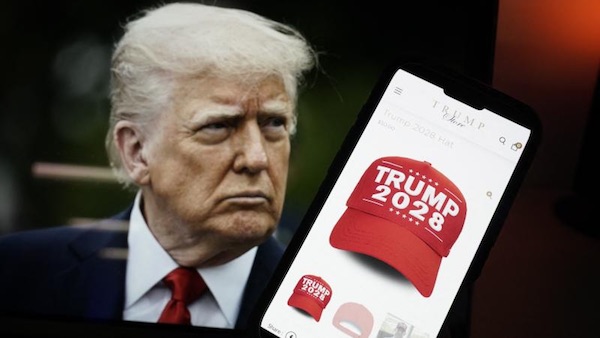
The Trump store website charges $50 for the Trump 2028 hat, and $36 for the shirts. “The future looks bright! Rewrite the rules with the Trump 2028 high crown hat,” a description of the item reads. “Fully embroidered with a snap closure in the back, this will become your new go-to hat.” One lawmaker, Tennessee GOP Rep. Andy Ogles, has suggested making it possible for presidents to serve three terms if they do not serve more than two terms back to back. This would allow Trump to seek a third term, because of the gap in his presidencies.




Autism
DR. PETER MCCULLOUGH: “Autism was one in 10,000 when I was a kid. It’s now one in 36.”
That explosive rise is finally being exposed by Secretary Kennedy and HHS.
Dr. McCullough says the timing is no coincidence.
The surge in autism, he explained, “appears to be associated with… pic.twitter.com/XWSt9PN7Rs
— The Vigilant Fox 🦊 (@VigilantFox) April 24, 2025

Cancer drug inventor Dr. Patrick Soon-Shiong acknowledges mRNA spike protein was designed to replicate itself to create destruction in the human body. pic.twitter.com/gGbaHDeUa4
— Red Pill Dispenser (@redpilldispensr) April 24, 2025

Growth
If you think overpopulation is a problem, you may be wrong.
Two centuries of rapid global population growth are coming to an end.
World population growth is a first derivative, in math terms, and peaked in 1968, going down almost continually ever since
UN projections show it… pic.twitter.com/KKuDHmKbTn
— Massimo (@Rainmaker1973) April 24, 2025

Lions
The insane size difference between a Lion and a Lioness. pic.twitter.com/29Lmu7pXWy
— Nature is Amazing ☘️ (@AMAZlNGNATURE) April 24, 2025

Eco
In 1960, David Latimer planted a spiderwort sprout inside of a large glass jar, added a quarter pint of water, and then sealed it shut.
He opened the bottle for the first time only 12 years later, in 1972, to add some water and then sealed it for good.
The self-contained… pic.twitter.com/ezDFW0On9w
— Massimo (@Rainmaker1973) April 24, 2025

Dressed
This video is hilarious! A must watch. 😂😂😂😂😂 pic.twitter.com/0Oj40tX0Px
— Suzie rizzio (@Suzierizzo1) April 23, 2025

Saw this on FB and had to share. 2A all the way.
Today I swung my front door wide open and placed my Remington 30.06 on the deck rail. I left six cartridges beside it, then left it alone and went about my business.
While I was gone, the mailman delivered my mail, my neighbor… pic.twitter.com/so3h2r3wEv
— Michelle Maxwell (@MichelleMaxwell) April 23, 2025
Today I swung my front door wide open and placed my Remington 30.06 on the deck rail. I left six cartridges beside it, then left it alone and went about my business. While I was gone, the mailman delivered my mail, my neighbor across the street mowed his lawn, a girl walked her dog down the street, and quite a few cars stopped at the stop sign near the front of my house. After about an hour, I checked on the gun. It was still sitting there, right where I had left it. It hadn’t moved itself off the deck rail. It hadn’t killed anyone, even with the numerous opportunities it had presented to do so.
In fact, it hadn’t even loaded itself. You can imagine my surprise, with all the hype by the Left and the Media about how dangerous guns are and how they kill people. Either the media is wrong or I’m in possession of the laziest gun in the world. The United States is third in murders throughout the World. But if you take out just four cities: Chicago , Detroit , Washington DC and New Orleans , the United States is fourth from the bottom, in the entire world, for murders.
These four Cities also have the toughest Gun Control Laws in the U.S. All four of these cities are CONTROLLED BY DEMOCRATS. It would be absurd to draw any conclusions from this data – correct? Well, I’m off to check on my spoons. I hear they’re making people fat .


Support the Automatic Earth in wartime with Paypal, Bitcoin and Patreon.

